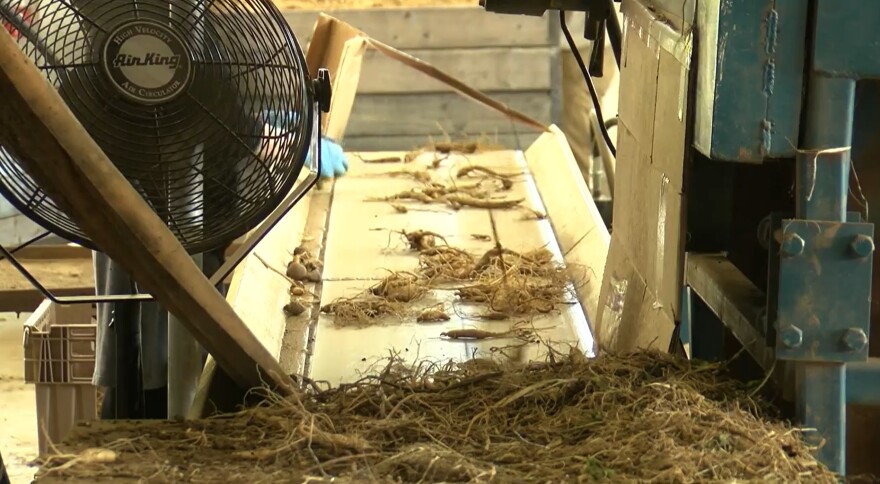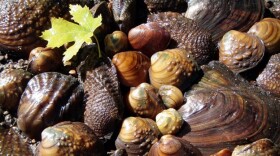It’s September and the time for gardeners and farmers to reap the rewards of a spring and summer of hard work. Despite our extensive cover of forests and lakes, streams and wetlands, there is lots of agricultural acreage in the Northwoods. The wild rice harvest is largely over, the cranberry harvest is coming up and potatoes will soon follow. But one of the crops most iconic to our area is ginseng, Panax quinquefolia. Marathon County, just south of Lincoln County is the center of ginseng farming, not just in Wisconsin but it is recognized as the largest source and the best quality of ginseng in the world.
Ginseng is a perennial herb, that is, a plant that dies back to the ground in winter, such as strawberries or buttercups but grows again the next year from its rootstock. The most prized part of ginseng is the root, which becomes thick with age. The most valued roots resemble the torso and legs of a human being. For centuries, the Ojibwe harvested ginseng for its cure of digestive problems or pain while other tribes used it for almost every ailment that plagued them. A different species of ginseng native to Asia, Panax ginseng has been harvested for its medicinal uses for thousands of years. Carl Linnaeus, who gave scientific names to many plants in the 19th century, named ginseng Panax, which means “Heal-all” in Greek. This is the same Greek root as the word “panacea”, meaning a remedy for all ills.
Wild ginseng can be found through much of the eastern United States, but it has been over-harvested and is now considered an endangered species in many states, including Wisconsin. However, ginseng has been cultivated in Wisconsin since the early 1900s and cultivation continues today. Marathon County in Wisconsin grows and sells about 95% of the United States’ cultivated ginseng. Most of this is exported to China and Asian communities in other parts of the world.
The active ingredients in ginseng were isolated as far back as the mid-1800s, and many studies, mostly by Korean, Chinese and Japanese researchers, have documented its effectiveness with problems of the central nervous system and cardiovascular diseases, as well as having anti-diabetic and anti-tumor properties. Ginseng users find it helps with respiratory issues, fatigue, endurance, stress and many other conditions. Scientific studies using western standards for clinical trials have not come to the same conclusions and ginseng is not widely used in western medicine. However, it is remarkable that Native American cultures and Asian cultures on opposite sides of the world independently recognized the medicinal qualities of these closely related plants.
Aside from its amazing cure-all properties, ginseng is an extraordinary plant. Cultivation is extremely time consuming, difficult and fraught with problems. First off, it takes 4-5 years for the plants to mature before the roots can be harvested, and any one of those years can doom the plants if the weather isn’t just right.
Second, the seeds for growing new plants must be harvested from older mature plants; they cannot be purchased from a seed company. The scarlet berries produced by mature plants are collected by hand and, following a cold treatment, will be sown into a prepared bed the next fall.
Third, because it is a plant of the forest, ginseng must be grown in the shade. Before the first growing season, poles are pounded into the soil, with cables strung between the poles. These will support the black fabric covers that will create the shade that blocks 75-85% of the sunlight. To me looking at the shades while whizzing by on Highway 51, it looks like the shades are only about waist high, but they are actually tall enough so that farm equipment and people can work under them.
Fourth, ginseng will not grow where it has been grown before, even after 40-50 years. So, the ginseng farmers generally rent the land where they will grow ginseng for the span of a few years to bring a crop to harvest. That land can then be used to grow corn or some other crop – almost anything other than ginseng. You might know that some plants, such as black walnut trees, produce a chemical that prevents other plants from growing beneath it, a condition known as allelopathy. This phenomenon, where ginseng will not grow where it has grown before, is a special case of allelopathy where the plant deposits chemicals into the soil making it unsuitable for the same species to grow there again.
While the Marathon County ginseng fields are a little south of most of WXPR’s listening audience, it is likely everyone has seen the ginseng fields as you pass through the Wausau area. As you drive by, appreciate the hardworking ginseng farmers, responsible for one of the Northwood’s greatest claims to fame.









